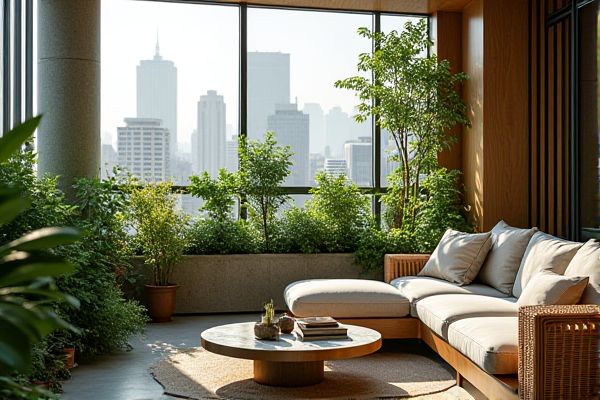
Balcony gardens maximize limited space with container plants and vertical gardening, ideal for urban dwellers seeking greenery without structural challenges, while rooftop gardens offer expansive planting areas and greater environmental benefits but require more planning and maintenance. Discover how to choose between a balcony or rooftop garden to best enhance Your urban living space by reading the full article.
Table of Comparison
| Feature | Balcony Garden | Rooftop Garden |
|---|---|---|
| Space Availability | Limited to balcony size, typically small-scale | Ample space, suitable for larger setups |
| Sunlight Exposure | Varies; often partial sunlight due to building shadows | Maximum sunlight; ideal for sun-loving plants |
| Weight Load Capacity | Limited; requires lightweight containers and soil | Higher; can support heavier plants and installations |
| Accessibility | Easy access from apartment or unit | May require stairs or elevator, less frequent access |
| Water Drainage | Must ensure proper drainage to avoid balcony damage | Better drainage options; roof designed to handle water |
| Plant Variety | Limited to small plants, herbs, and ornamental flowers | Supports shrubs, vegetables, trees, and diverse plants |
| Installation Cost | Lower cost; simple setup | Higher cost; may require structural modifications |
| Maintenance | Easy to maintain; frequent attention needed | Moderate to high; larger area requires more effort |
| Thermal Insulation | Provides minimal insulation benefits | Significant insulation; reduces building heat absorption |
Introduction to Balcony and Rooftop Gardens
Balcony gardens maximize small urban spaces by using containers and vertical planting systems, ideal for apartments and limited outdoor areas. Rooftop gardens transform flat roof surfaces into lush green spaces, offering extensive planting opportunities and potential for urban agriculture. Both options enhance air quality and provide personal green retreats, but differ in scale, structural requirements, and sunlight exposure.
Space and Layout Considerations
Balcony gardens typically offer limited space, making vertical planters and compact containers ideal for maximizing greenery in small areas. Rooftop gardens benefit from larger, open layouts that allow for diverse planting arrangements, including trees, shrubs, and seating zones to create a multi-functional outdoor space. Your choice depends on available square footage and the structural capacity of your balcony or rooftop to support soil and plant weight.
Sunlight and Exposure Differences
Balcony gardens typically receive limited sunlight due to their proximity to building walls and neighboring structures, affecting plant growth and requiring shade-tolerant species. Rooftop gardens benefit from unobstructed sunlight and greater exposure, promoting healthier plant development and allowing for a wider variety of sun-loving plants. Your choice should consider these sunlight and exposure differences to ensure optimal garden success.
Weight and Structural Limitations
Balcony gardens require careful consideration of weight restrictions due to limited load-bearing capacity, often supporting only lightweight containers and soil to prevent structural damage. Rooftop gardens typically accommodate heavier loads, allowing for deeper soil layers and larger plants, but still need professional assessment to ensure the roof's structural integrity can handle added weight, including water retention systems. Both garden types demand proper drainage solutions to avoid water accumulation that could compromise the building's framework.
Plant Selection for Each Garden Type
Balcony gardens typically require compact, lightweight plants such as herbs, succulents, and dwarf vegetables that thrive in limited space and container environments with partial sunlight. Rooftop gardens can support a wider range of plant species, including larger shrubs, trees, and perennial flowers, benefiting from deeper soil beds and full sun exposure, which accommodate more extensive root systems. Optimal plant selection depends on structural capacity, sunlight availability, and maintenance considerations unique to each garden type.
Irrigation and Drainage Solutions
Balcony gardens require compact irrigation systems such as drip emitters and self-watering containers to optimize water use and prevent overwatering in limited space. Rooftop gardens need advanced drainage solutions like layered substrates and integrated drainage mats to manage larger water volumes and prevent structural damage. Both spaces benefit from automated irrigation timers and rainwater harvesting to maintain plant health efficiently.
Privacy and Aesthetic Opportunities
Balcony gardens offer enhanced privacy due to their enclosed nature, allowing for intimate green spaces shielded from neighbors and street views. Rooftop gardens provide expansive aesthetic opportunities, with broader design possibilities and panoramic views that create visually stunning environments. Both options can be tailored with vertical plants, trellises, and decorative elements to maximize privacy and visual appeal.
Maintenance Challenges and Tips
Balcony gardens require careful attention to container selection, watering frequency, and weight limits to avoid structural damage, while rooftop gardens demand robust waterproofing, drainage systems, and wind protection to maintain plant health and roof integrity. Regular monitoring for pest infestations, soil quality, and sunlight exposure is essential in both settings to prevent plant stress and optimize growth. Using lightweight soil mixes, drip irrigation systems, and choosing resilient plant species can help reduce maintenance efforts and enhance garden sustainability.
Cost and Setup Comparison
Balcony gardens generally require a lower initial investment, with costs mainly focused on portable pots, soil, and lightweight plants suitable for limited space, while rooftop gardens often demand a higher budget due to structural reinforcement, waterproofing, and irrigation systems. Setup for balcony gardens is simpler and quicker, ideal for small-scale urban gardening, whereas rooftop gardens involve complex planning, including load-bearing assessments and professional installation to ensure safety and sustainability. Your choice depends on budget constraints and willingness to invest in construction and maintenance, making balcony gardens more accessible but rooftop gardens capable of supporting larger, more diverse plantings.
Environmental Impact and Benefits
Balcony gardens improve urban air quality by reducing carbon dioxide levels and providing habitats for pollinators in limited spaces, contributing to microclimate cooling and noise reduction. Rooftop gardens offer significant environmental benefits through substantial stormwater retention, insulation that reduces building energy consumption, and enhanced biodiversity by creating larger green habitats. Both setups play crucial roles in urban sustainability, with rooftop gardens typically having a higher impact due to their scale and ability to integrate advanced green technologies.
 homyna.com
homyna.com